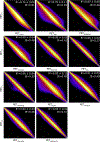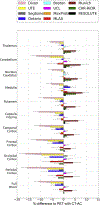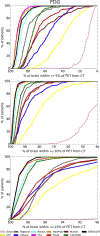A multi-centre evaluation of eleven clinically feasible brain PET/MRI attenuation correction techniques using a large cohort of patients
- PMID: 27988322
- PMCID: PMC6818242
- DOI: 10.1016/j.neuroimage.2016.12.010
A multi-centre evaluation of eleven clinically feasible brain PET/MRI attenuation correction techniques using a large cohort of patients
Abstract
Aim: To accurately quantify the radioactivity concentration measured by PET, emission data need to be corrected for photon attenuation; however, the MRI signal cannot easily be converted into attenuation values, making attenuation correction (AC) in PET/MRI challenging. In order to further improve the current vendor-implemented MR-AC methods for absolute quantification, a number of prototype methods have been proposed in the literature. These can be categorized into three types: template/atlas-based, segmentation-based, and reconstruction-based. These proposed methods in general demonstrated improvements compared to vendor-implemented AC, and many studies report deviations in PET uptake after AC of only a few percent from a gold standard CT-AC. Using a unified quantitative evaluation with identical metrics, subject cohort, and common CT-based reference, the aims of this study were to evaluate a selection of novel methods proposed in the literature, and identify the ones suitable for clinical use.
Methods: In total, 11 AC methods were evaluated: two vendor-implemented (MR-ACDIXON and MR-ACUTE), five based on template/atlas information (MR-ACSEGBONE (Koesters et al., 2016), MR-ACONTARIO (Anazodo et al., 2014), MR-ACBOSTON (Izquierdo-Garcia et al., 2014), MR-ACUCL (Burgos et al., 2014), and MR-ACMAXPROB (Merida et al., 2015)), one based on simultaneous reconstruction of attenuation and emission (MR-ACMLAA (Benoit et al., 2015)), and three based on image-segmentation (MR-ACMUNICH (Cabello et al., 2015), MR-ACCAR-RiDR (Juttukonda et al., 2015), and MR-ACRESOLUTE (Ladefoged et al., 2015)). We selected 359 subjects who were scanned using one of the following radiotracers: [18F]FDG (210), [11C]PiB (51), and [18F]florbetapir (98). The comparison to AC with a gold standard CT was performed both globally and regionally, with a special focus on robustness and outlier analysis.
Results: The average performance in PET tracer uptake was within ±5% of CT for all of the proposed methods, with the average±SD global percentage bias in PET FDG uptake for each method being: MR-ACDIXON (-11.3±3.5)%, MR-ACUTE (-5.7±2.0)%, MR-ACONTARIO (-4.3±3.6)%, MR-ACMUNICH (3.7±2.1)%, MR-ACMLAA (-1.9±2.6)%, MR-ACSEGBONE (-1.7±3.6)%, MR-ACUCL (0.8±1.2)%, MR-ACCAR-RiDR (-0.4±1.9)%, MR-ACMAXPROB (-0.4±1.6)%, MR-ACBOSTON (-0.3±1.8)%, and MR-ACRESOLUTE (0.3±1.7)%, ordered by average bias. The overall best performing methods (MR-ACBOSTON, MR-ACMAXPROB, MR-ACRESOLUTE and MR-ACUCL, ordered alphabetically) showed regional average errors within ±3% of PET with CT-AC in all regions of the brain with FDG, and the same four methods, as well as MR-ACCAR-RiDR, showed that for 95% of the patients, 95% of brain voxels had an uptake that deviated by less than 15% from the reference. Comparable performance was obtained with PiB and florbetapir.
Conclusions: All of the proposed novel methods have an average global performance within likely acceptable limits (±5% of CT-based reference), and the main difference among the methods was found in the robustness, outlier analysis, and clinical feasibility. Overall, the best performing methods were MR-ACBOSTON, MR-ACMAXPROB, MR-ACRESOLUTE and MR-ACUCL, ordered alphabetically. These methods all minimized the number of outliers, standard deviation, and average global and local error. The methods MR-ACMUNICH and MR-ACCAR-RiDR were both within acceptable quantitative limits, so these methods should be considered if processing time is a factor. The method MR-ACSEGBONE also demonstrates promising results, and performs well within the likely acceptable quantitative limits. For clinical routine scans where processing time can be a key factor, this vendor-provided solution currently outperforms most methods. With the performance of the methods presented here, it may be concluded that the challenge of improving the accuracy of MR-AC in adult brains with normal anatomy has been solved to a quantitatively acceptable degree, which is smaller than the quantification reproducibility in PET imaging.
Keywords: Attenuation correction; Brain; PET/MRI.
Copyright © 2016 The Authors. Published by Elsevier Inc. All rights reserved.
Figures








References
-
- Aitken AP, Giese D, Tsoumpas C, Schleyer P, Kozerke S, et al., 2014. Improved UTE-based attenuation correction for cranial PET-MR using dynamic magnetic field monitoring. Med. Phys 41, 012302. - PubMed
-
- Aljabar P, Heckemann RA, Hammers A, Hajnal JV, Rueckert D, 2009. Multi-atlas based segmentation of brain images: atlas selection and its effect on accuracy. Neuroimage 46 (3), 726–738. - PubMed
-
- Andersen FL, Ladefoged CN, Beyer T, Keller SH, Hansen AE, et al., 2014. Combined PET/MR imaging in neurology: MR-based attenuation correction implies a strong spatial bias when ignoring bone. Neuroimage 84, 206–216. - PubMed
-
- Andreasen D, Van Leemput K, Hansen RH, Andersen JA, Edmund JM, 2015. Patch-based generation of a pseudo CT from conventional MRI sequences for MRI- only radiotherapy of the brain. Med. Phys 42, 1596–1605. - PubMed
Publication types
MeSH terms
Substances
Grants and funding
LinkOut - more resources
Full Text Sources
Other Literature Sources
Medical

